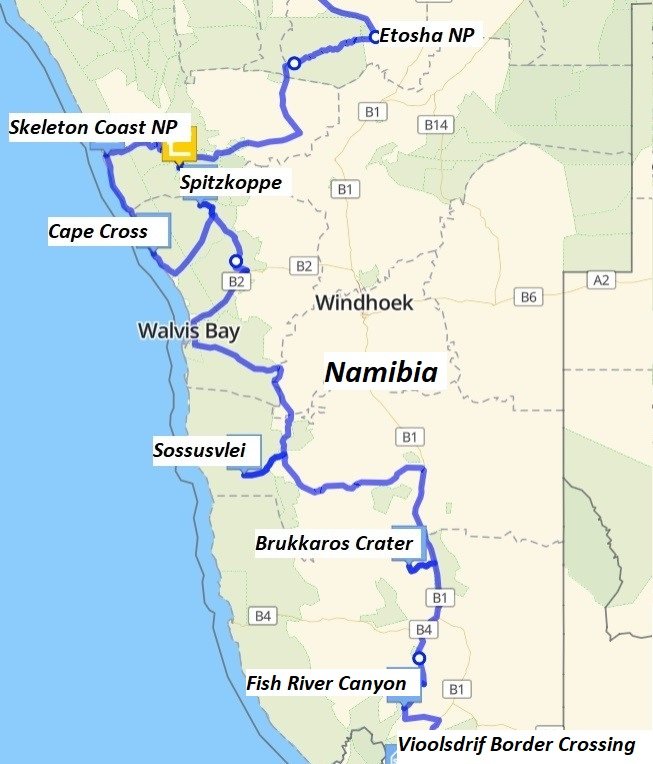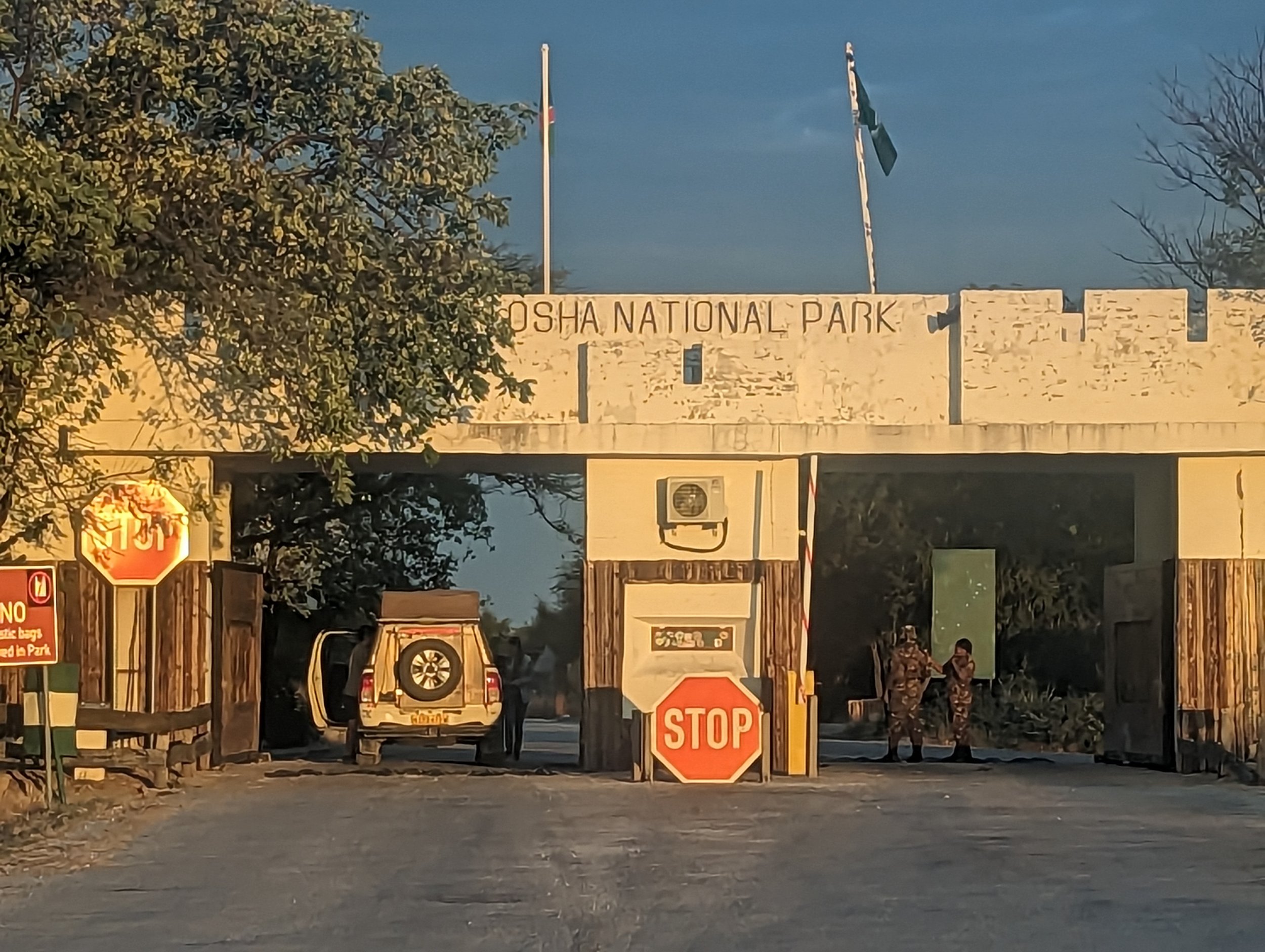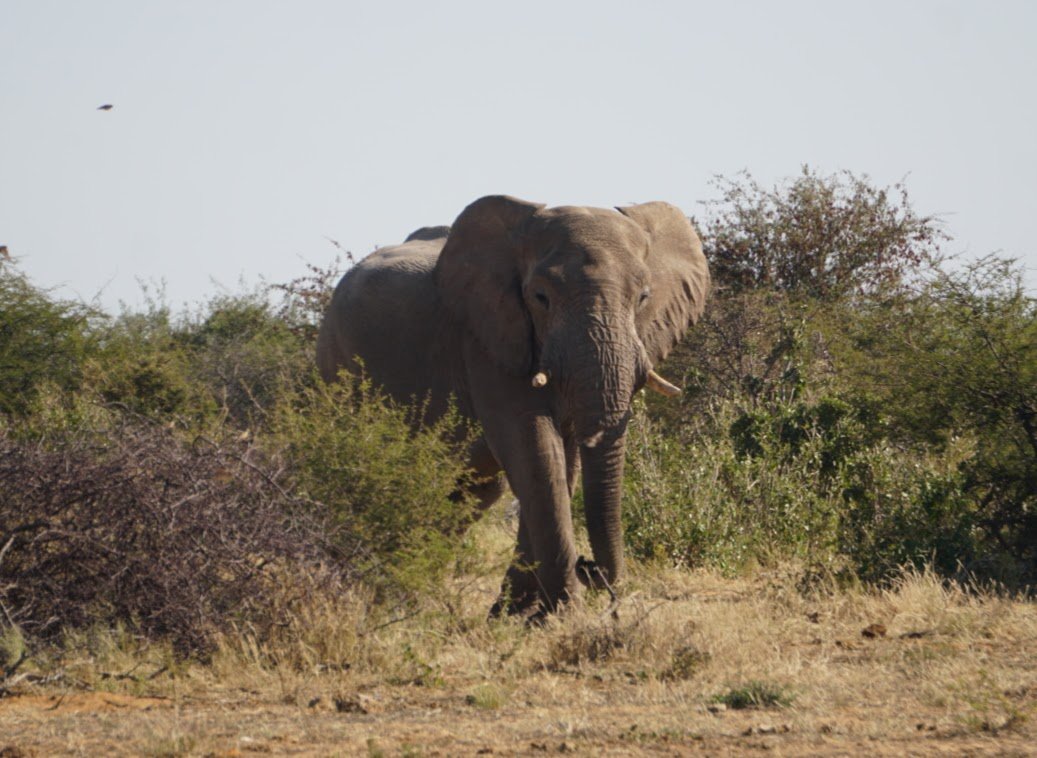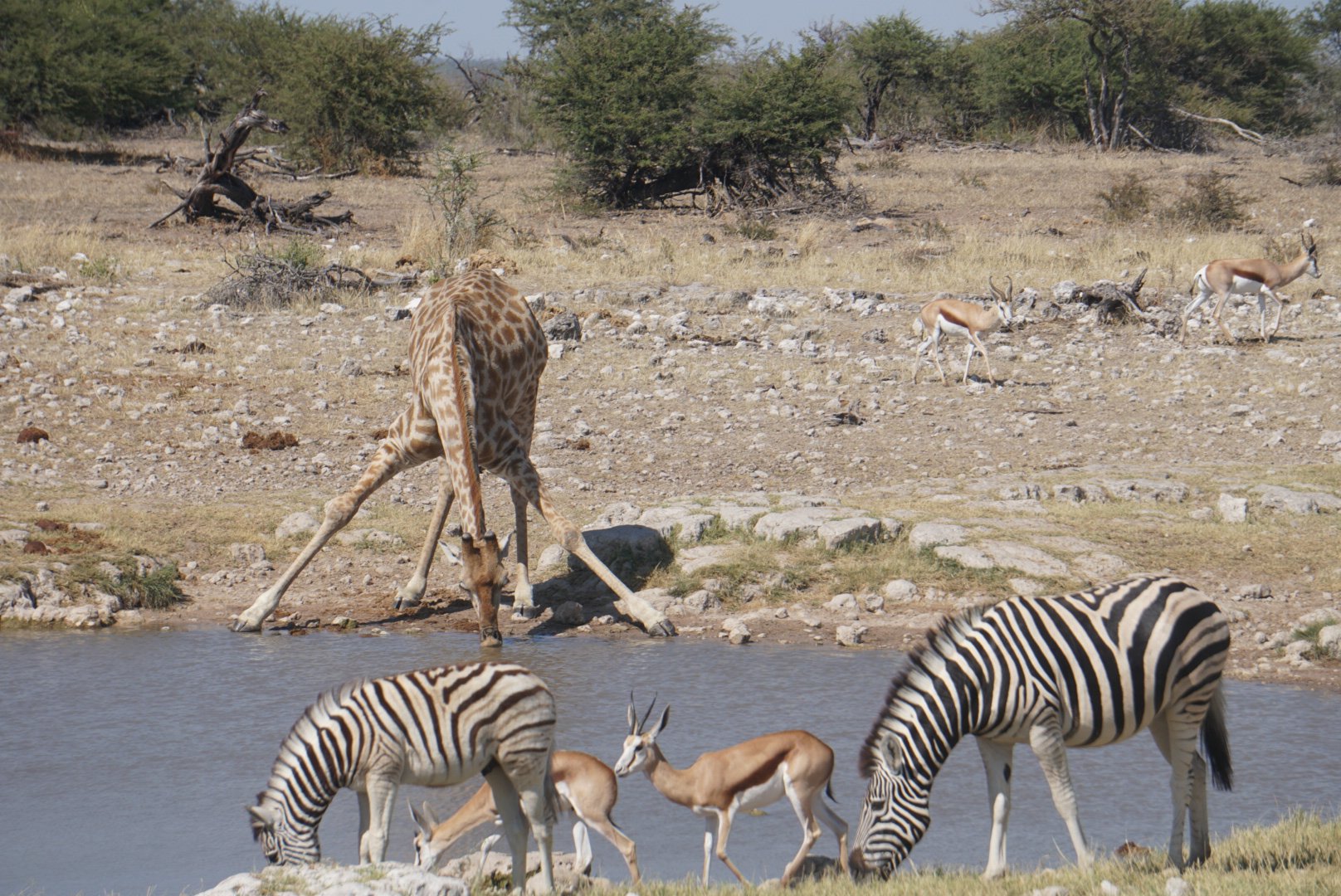Namibia
Morning lion siting in Etosha National Park
After traveling in Africa for six months with very little wildlife viewing, we were hungry to see animals. Namibia definitely delivered. Etosha National Park was a corunucopia of wildlife.
But it was also a shock to our systems to all of a sudden be surrounded by tourists in rented trucks everywhere we went. The towns had a modern feel with restuarants, cafes, paved streets and street lights. Initially, access to huge, modern European style markets was exciting but soon the excitement was replaced with a sense of remorse. All of a sudden we missed the crazy chaos of the community markets in West Africa, the warmth the curiosity and the friendliness. The big air conditioned markets with their shrink wrapped products felt easy but they were missing life and character. A sad example of the grass is always greener.
We did appreciate the ease of traveling in Namibia as a visitor though. Tourist infrastructure was well developed, information was easy to find and there were plenty of camping facilities. We were also relieved to once again be able to speak English and be able to communicate easily.
Our two week route through Namibia
A new nation, Namibia obtained independence in 1989 after decades of armed struggle, first with German occupiers then with South African control. The country was established with a constitution establishing a multi party system and a comprehensive Bill of Rights. Leadership under the first elected president, Sam Nujoma who had lead the fight for independence was focused on reconciliation from the years of war and on reconstruction.
Compared to many of it’s neighbors, Namibia is politically stable and economically prosperous. It struggles with issues of wealth disparity, but the growth in the diamond, uranium and tourism sectors are providing jobs. One out of five people works in the tourism industry. The country has one of the lowest population densities in Africa and is the people are young - with over 60% being under 25 years old.
We crossed into Namibia from Angola at a small border crossing and our first experience was being unable to pay the required road tax as power was out, no credit card processing, and we had no Namibian cash. No problem, we were allowed to go with a promise we would return and pay the next day. The regional power outage meant no access to gas (we were almost empty), cash or sim cards for phone service but we found a place to camp and wait it out. The Kunene River region was a great transition to what was coming at Etosha, as we were re-rentering civilization after days in the Namibe desert. Women in traditional Himba dress (hair designed and coated in red ochre with natural clothing made from animal skins, typically bare on top with beautifully designed jewelry) walked the dusty village streets alongside women in European fashions.
Early mornibng entrance into Etosha National Park
Eventually the power came on, we were able to access cash, buy gas, groceries and sim cards and we were on our way. We had booked campsites in advance in Etosha. Not cheap at $42 for a site for two people, but the location was worth the cost. It was a little unnerving though, campgrounds closed access from sunset to sunrise with campers enclosed in an electrified compound with a gate. We understood why when we listened to the lions roraring and hunting all night, but we did miss the sense of adventure. We remembered being in Botswana national parks and running the risk of encountering an elephant on the way to the restroom in the evening. Even though we could not explore at night, all of the campgrounds had large water holes at with viewing areas at the edge of the camp so that you could still view evening wildlife activity.
We spent four nights in the park, working our way from east to west. At each camp, we would wake up early, head out at sunrise as soon as the campground gates opened, (Dawn with coffee in hand) and make our way to a watering hole and sit and watch the comings and goings. Then back to the campground to relax, take showers then set off on a late afternoon drive to watch the evening parade. It never got old, the elephants bathing with their babies, the grumpy zebras snapping at each other and the majestic lions ambling slowly in to drink before or after a night of hunting.
Namutoni Camp, Etosha National Park
Our first camp, Namutoni ended up being our favorite. More low key in terms of facilities, the sites were spread out on the grass with trees for shade. It was the closest to really active watering holes and during the time we were there we saw several lion prides. It also had amazing water pressure in the shower facilities! The only drawback was that it’s onsite watering hole was small and did not seem to attract much when we were there (May).
So thrilled to find rhinos on our very first drive in Etosha
There is just something so exciting about the first time you see an elephant pop out of the bush
The poor giraffes - so awkward for them to drink
One morning we were sitting at an empty watering hole as the solitary watchers, waiting to see if anything would happen and a leopard slunk out of the bushes to drink. All of a sudden it jumped up and ran off, right in front of our truck. We wondered what made it take off so abruptly.
And then the lions arrived and we realized why.
Our second camp was Halali. Bigger than Namutoni, but still smaller than Okaukuejo, it had an awesome nighttime watering hole. We were getting into the rhythm with the morning and evening drives and relaxing into sitting by a hole just to see what would appear.
Kudu
Zebra and impalas
Zebra fight - a common occurrence
Oryx
Spent a delightful hour watching elephant moms and babies bathing
Ostrich
Wildebeast
Halali Camp - sandy spots
Sun goes down on the Halali Watering Hole
And here come the rhinos! Hyenas too - our first sighting, but the pictures of them did not turn out
Our last camp was Okaukuejo, definitely the most developed with a large pool and restaurant and tourist shops. Buses came and went and the camping area was more densely populated (with only one toilet building). It had a large active evening watering hole - more rhinos!
Typical mid day at a watering hole - not too much going on
Sun goes down on the Okaukuejo Watering Hole
Feeling satiated with animal sitings (only one hold out we have not been able to check off so far - a cheetah) we left Etosha to seek out some cultural experiences. Next stop, rock carvings at Twyfelfontein.
Most famous carving at Twyfelfontein,
An example of tourism done well, visitors are greeted at a simple museum site and gathered into small groups for a 45 minute guided walk. The site has been inhabited for 6,000 years, used as a site of worship first by hunter-gatherers and later by Khoikhoi herders. It is estimated that there are over 2,500 rock carvings, one of the largest concentrations of rock petroglyphs in Africa.
The valley at Tyfelfonstein
From the inland desert we made our way to the coast, exploring some side roads along the way. Beautiful and varied empty desert scenery and glorious weather made for fun driving.
Exploring some back roads in the desert
Side road to our wild camping spot for the night
Beautiful site - we saw mountain zebras in the distance
We were thrilled with the site we found until we were visited in the morning by some local tour operators with a truck full of tourists. They were kind but informed us that we were not actually allowed to camp there and that we were at risk by being robbed by local villagers. We were not sure what to make of this, not having seen a soul for miles but thanked them for their concern and packed up.
Our next stop was the Skeleton Coast National Park which although bleakly beautiful did not offer up the miles of derelict shipwrecks we were expecting. On the upside, most of them have been cleaned up and the wrecks have not been recurring. You must enter and exit the park in the same day, driving through does not cost anything.
Main (impregnated salt)) road through Skeleton Coast National Park
We never saw the coastal lions
Stopping for a walk at one of the few remaining wrecks
We had a pleasant and scenic day, even wore our coats for the first time in months. We exited the park and decided to go visit the seals at Cape Cross Seal Reserve. We have never seen so many seals in our lives. The smell was off the charts, but it was still fun to watch their antics.
Cape Cross Seal reserve
Just us and the seals
Before we started smelling like 10,000’s of seals, we drove down the coast to a great wild camping spot north of Swakopmund.
Coastal wild camping spot outside of Swakopmund
Visited by jackals in the night
They stole our camp shoes but Andy found them in the dunes. Dawn’s a little worse for wear with the tongue chewed off, but still wearable
We took care of some business in Swakopmund, including having a tire repaired (slow leak from a ripped side wall from the Angolan desert drive), stocking up on groceries and gas. The town felt like a standard tourist town, lots of amenities, shopping and tourism operators but didn’t feel like a place we wanted to stay long.
We headed inland to the tallest peaks in Namibia at Brandberg National Monument.
Road in to Brandberg, highest peaks in Namibia
The story of Andy’s life in Namibia, air up, air down, endless varieties of softness of sand and corrugation
Another well run tourist site, we were greeted at the entrance and assigned a guide to walk us in to see the famous White Lady rock paintings. Our guide was from Damaraland, a native San who spoke the Khoisan language. He demonstrated for us the famous clicking language -it sounded like music. He explained that recent studies theorize that the ancient language was likely the first form of oral language with some of the clicking sounds gradually being replaced by words over time.
Famous “White Lady” rock painting (actually a man)
Hiking with our guide
More glorious sunny weather finished with cultural sites for the time being and we were off to Spitzkoppe, renowned rock formations rising out of the desert.
Road to Spitzkoppe
Wandering around the Spitzkoppe formations
And then back to the coast. We were happy to have the guides and information at the cultural sites, but we were hoping we could find our way into Sandwich Harbor on our own. Amazing dunes on the coast, numerous four by four operators offered to drive people in for a hefty fee. We thought it would be more funt to go on our own, but we had heard of challenges, including vehicles being swept away by incoming tides.
Drizzly walk along the coast in Walvis Bay
Walvis Bay felt like one of the most touristy spots we had been in a long time. Outdoor operators and expensive cafes lined streets along with B&Bs and guest houses. We went for a walk, watched the coastal flamingos then decided to see if we could drive to Sandwich Harbor. It was a big “no.”
The point we turned back on the road to Sandwich Harbor, we are just too heavy.
So we left the coast to explore our last two iconic natural wonders in Namibia.
Despite its decrepit state, one of the most photographed signs in Namibia
Sossusvlei is one of Namibia's most spectacular landmarks with its red dunes and the white salt pan at Deadvlei.
Completely unedited phone photo - the scenery was extraordinary
It was hot - we were tempted to share the shade with the oryx
Another area with a requirement to exit by sunset, we left Sossusvlei to find some wild camping. Spending many nights in camp grounds with people around was getting to us and were looking for some privacy and space. We found our spot at Brukkaros Crater, solitary hiking and camping with a view for miles.
Hiking at Brukkaros Crater
Friendly hyrax along the trail
Inside the volcanic crater
Preparing the evening meal, Dawn was thrilled to find lots of fresh vegetables at the market in Walvis Bay. Andy not so much.
Attempting to tuck out of the wind by an abandoned structure
And then our final stop in this engaging, young country - Fish River Canyon. Another site with no access out of daylight hours (unless you are doing a multi-day arduous through hike) we drove in and wandered along the canyon’s edge.
Parked at the edge of Fish River Canyon
Impressive as the sun goes down
Sun goes down on our final camp in Namibia
Namibia was an easy break after six months of much more challenging travel down the West Coast. It reminded us of our trip to Botswana years before when we had been one of the many tourists in rented trucks with a roof top tent. That first trip to Africa was when we realized how easy and fun it was to travel overland.
But we were still thinking back with wonder on the adventure of being the only tourists for 100’s of miles as a contrast to Namibia where we were among the many. There are benefits to both and we are lucky to have experienced many aspects of overlanding in Africa. Next up, South Africa, and looking forward to a break at home in Oregon with family and friends while the truck gets some much needed maintenance in a Cape Town offroad shop. Thank you for reading and coming along on this journey with us!



































































